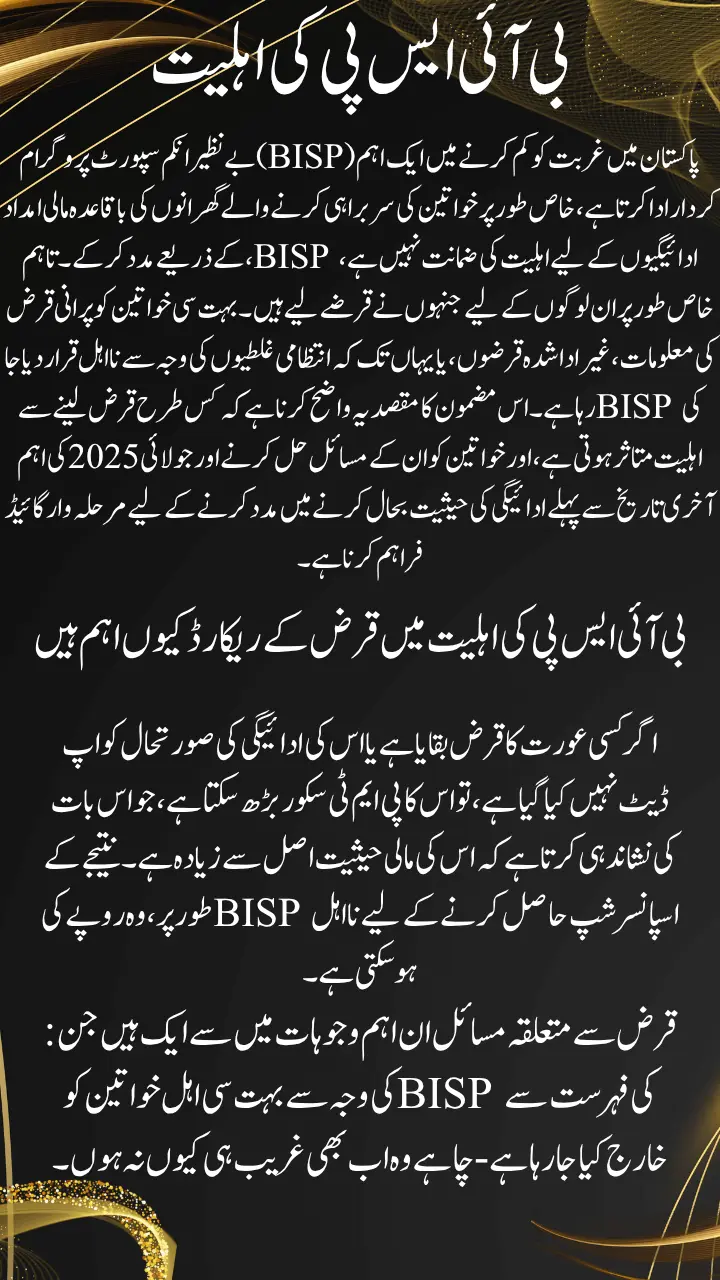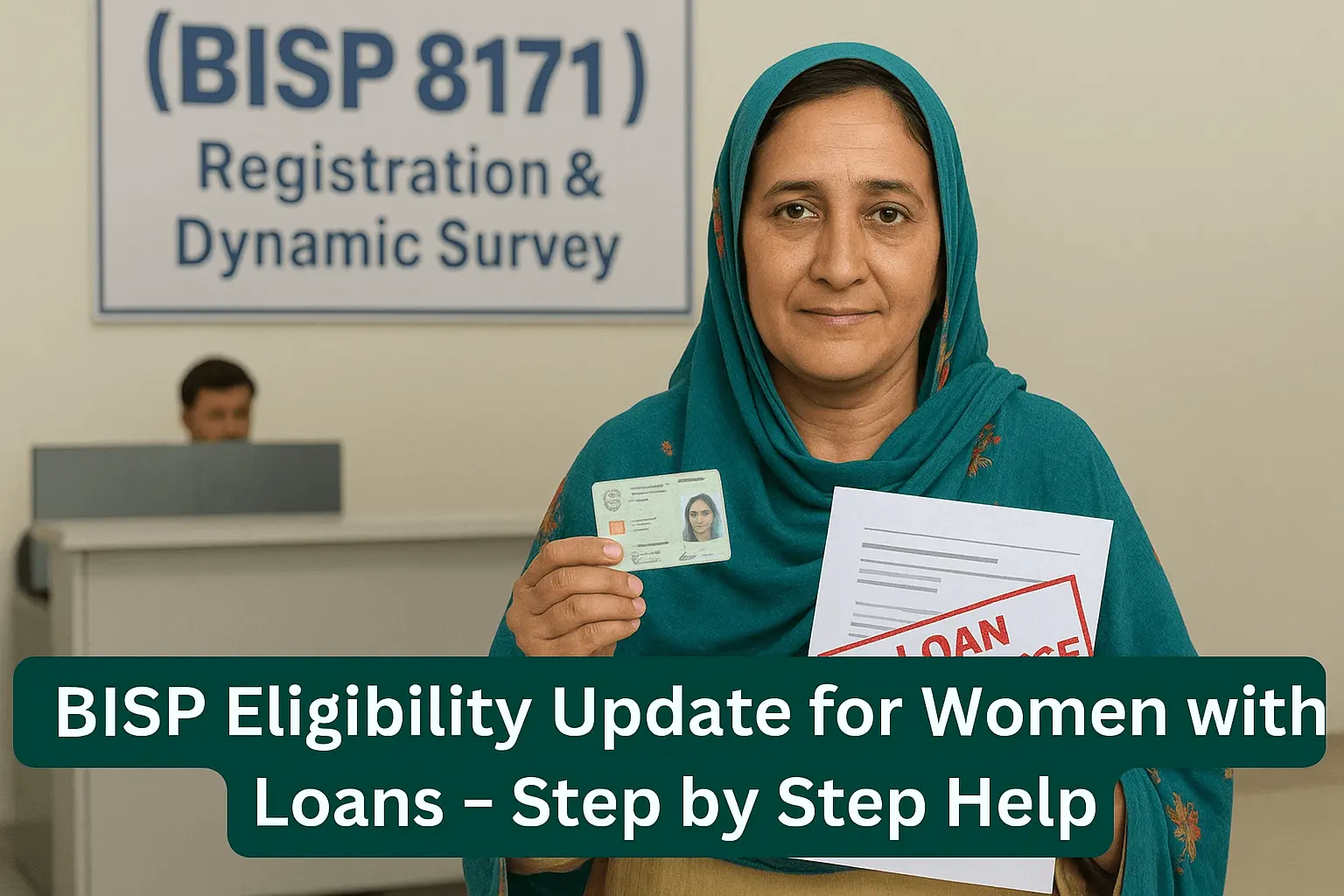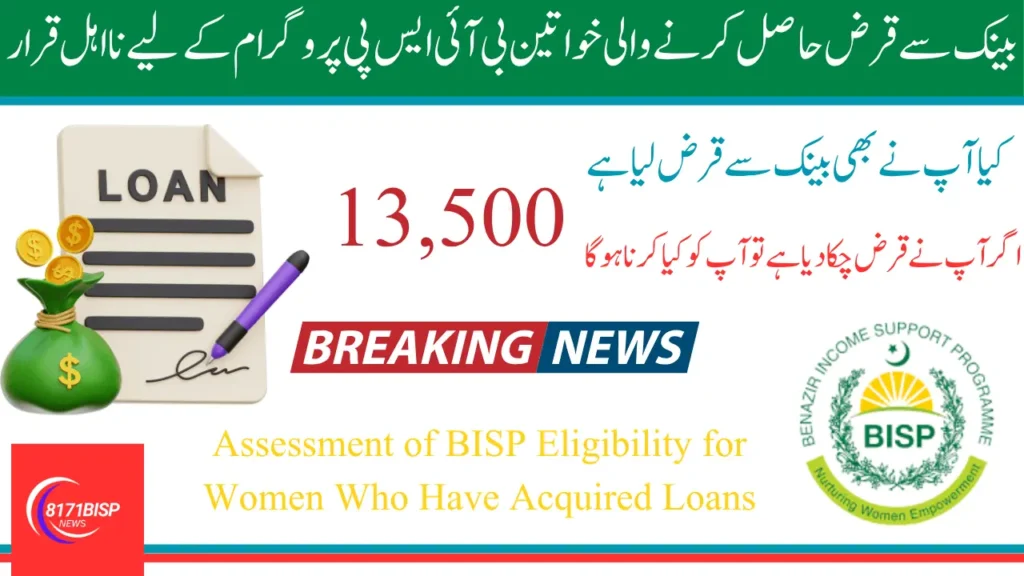BISP Eligibility for Women
BISP Eligibility for Women: The Benazir Income Support Program (BISP) plays a vital role in reducing poverty in Pakistan, especially by supporting women-led households through regular financial assistance. However, eligibility for BISP payments isn’t guaranteed, especially for those who have acquired loans. Many women are being marked ineligible due to outdated loan information, unpaid debts, or even administrative errors.
This article aims to clarify how taking a loan affects BISP eligibility, and provides a step-by-step guide to help women resolve their issues and restore their payment status—before the critical July 2025 deadline.
Why Loan Records Matter in BISP Eligibility
BISP determines eligibility based on the National Socio-Economic Registry (NSER), which calculates a Poverty Means Test (PMT) score. This score reflects a household’s financial condition, including income, assets, and financial activity, such as loan borrowing.
If a woman has an outstanding loan or her repayment status is not updated, her PMT score might increase, signaling a higher financial standing than she actually has. As a result, she may be disqualified from receiving the BISP Kafalat installment of Rs. 13,500.
🔺 Important: Loan-related issues are one of the top reasons many eligible women are being removed from the BISP list—even if they are still poor.
Also Read:BISP 2025 Registration Guide: Why the NSER Survey is Crucial for Continued Payments
Types of Loans That May Affect Your Eligibility
Not every loan is a red flag, but some are closely monitored by government-linked financial systems:
-
Personal Loans from commercial banks
-
Auto Loans or Leasing Programs
-
Microfinance Loans (e.g., from Khushhali Bank, Akhuwat)
-
Business or Agriculture Loans, especially under government schemes
-
Unpaid Credit Card Dues
-
Loans under programs like Kamyab Jawan or Youth Development Initiatives
These loans are visible in State Bank databases, and BISP-linked systems like NSER use this information to assess eligibility.

If You Have Taken a Loan But Haven’t Repaid It
Women who haven’t repaid their loans are automatically flagged in national databases. Here’s what you need to do:
✅ Step-by-Step Action Plan:
-
Start repaying the loan immediately, even if through small installments.
-
Contact your bank or loan institution to request a payment schedule.
-
After repayment, ask for a Loan Clearance Certificate.
-
Ensure the bank removes your name from the defaulter list in their system.
-
Visit your nearest BISP Tehsil Office with your CNIC and clearance document.
-
Request a Dynamic NSER Survey to update your financial record.
🛑 Note: Unless your defaulter status is cleared officially, BISP will continue marking you ineligible—even if you’re living below the poverty line.
If You Repaid Your Loan, But the Bank Didn’t Update Your Record
Thousands of women are wrongly disqualified from BISP because their loan repayment hasn’t been reflected in the system. In this case, you must correct the error.
✅ Here’s what to do:
-
Visit the bank or loan provider and ask them to update your loan status.
-
Request a written confirmation or a clearance certificate.
-
Take this certificate to the BISP Tehsil Office along with your CNIC.
-
Ask the staff to update your NSER profile using your latest financial documents.
-
If needed, re-register for the Dynamic Survey.
📢 Keeping your financial record clean is essential. A paid-off loan that’s still marked as unpaid can block your right to receive financial help.
How to Update NSER Records After Loan Clearance
Once your loan is cleared and your bank has issued the required documents, your next step is to update your record with BISP through the NSER Dynamic Registration process.
✅ What to Bring:
-
Original CNIC
-
Loan Clearance Certificate or repayment proof
-
Family and income details (if required)
✅ Steps:
-
Go to the BISP Tehsil Office in your district.
-
Request the Dynamic Survey Form.
-
Fill in updated income, dependents, marital status, or any disability status.
-
Submit the form along with your supporting documents.
-
Ask for a confirmation receipt and wait for verification.
Usually, the status is updated within 5–7 working days.

Also Read:BISP 2025 Budget Update: 1 Crore Women to Be Included in Benazir Income Support Program
How to Check Your Updated BISP Status
Once you’ve completed the survey and updated your records, it’s important to check whether you are now eligible to receive the payment.
✅ Methods:
1. SMS Method:
-
Send your 13-digit CNIC to 8171
-
You will receive a message showing your current eligibility or pending status.
2. BISP Office Visit:
-
Bring your CNIC and ask for your status update at the help desk.
-
The staff will verify your updated eligibility and payment approval.
What to Do If PMT Score Remains High After Updates?
Sometimes, even after clearing your loan, your PMT score might still be too high (above 34%). This usually happens due to outdated household data.
Here’s how to fix it:
✅ Final Fix Plan:
-
Visit your BISP office and request a fresh Dynamic Survey.
-
Provide updated information about:
-
Change in income
-
Job loss or reduced earnings
-
Divorce, widowhood, or separation
-
Disability or serious illness
-
Any recent births or deaths in the household
-
-
Submit all relevant documents to prove your current financial struggles.
The goal is to recalculate your PMT score based on your real-life situation, not just old bank records.
Final Deadline: What Must Be Done Before July 1, 2025
The next BISP payment of Rs. 13,500 is expected in early July 2025. If your loan-related issues remain unresolved, you will not receive this installment.
✅ Urgent Action Plan:
-
Repay pending loans (or arrange a settlement).
-
Obtain a clearance letter from the bank.
-
Visit the BISP office and update your NSER profile.
-
Request a dynamic survey if the PMT score is still high.
-
Verify your eligibility through 8171 SMS before July 1.
⏰ Missing this deadline may delay your payment by several months, as you will have to wait for the next assessment cycle.
Conclusion
Women across Pakistan depend on BISP for survival. But unpaid or unreported loans—whether from a commercial bank or a microfinance institution—can silently disqualify deserving families. The good news? You can fix it—and in most cases, the process is straightforward.
-
Repay your loan or get a bank clearance.
-
Update your NSER data.
-
Submit a new dynamic survey if your PMT score is too high.
-
Use 8171 or visit the BISP office regularly to check your eligibility.
Taking these timely steps can help restore your financial support and protect your family’s future.
FAQs
Q1: Why does a loan affect my BISP eligibility?
Because loans raise your Poverty Means Test (PMT) score, which can mark you as financially stable, even if you’re not.
Q2: I have repaid my loan, but my BISP status is still blocked. What should I do?
Get a clearance certificate from your bank and visit the BISP office to update your NSER profile.
Q3: How can I check my BISP eligibility?
Send your CNIC to 8171 or visit your nearest BISP Tehsil Office.
Q4: What if my PMT score is still high after resolving the loan issue?
Request a new Dynamic Survey and update your income, family, and hardship details.
Q5: What must I do before July 2025 to get my payment?
Repay loans, update your NSER data, and confirm eligibility through 8171 before July 1.

